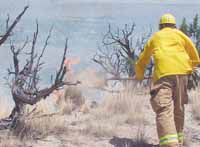| A fire fighter battles to control a burning cedar tree in the hills near Helper last summer. The open burn season in the unincorporated areas of the county ended June 1. Residents who are planning to conduct open burns between now and Nov. 1 must obtain permits from the county fire warden. |
The fire danger in Carbon County is extreme. Voluntary compliance to conservation efforts has created a dry, potentially volatile situation throughout the county.
“Right now, things are very dry and the fire danger is very high,” explained Carbon fire warden Rudy Sandoval. “The state hasn’t done a closure on campfires in approved areas yet, but other burning is closed without a permit.”
The open burn season closure became effective June 1.
Sandoval is in charge of issuing permits when Carbon and Emery residents want to construct a fire.
When requests are made, he visits the proposed site and makes sure people planning a controlled burn are prepared to handle any problems that may arise.
Last summer, Sandavol got dozens of calls from people wanting to burn grass clippings, branches, weeds and various materials.
When he arrived at the proposed sites, the warden sometimes found that local residents did not realize how easily a controlled burn could turn into a wildfire.
In the past, the blazes were considered by many people to be only a threat to forests, vegetation and wildlife. But with development booming in many areas and construction of summer homes or cabins, the chances for property damage and injury or death increase every season.
Cities have also expanded, blurring the urban-wildland interface. Problems that have increased the risks include:
•Many people want to live in secluded areas, but fail to leave a defensible space between natural vegetation and structures.
•Many secluded homes are built of wood products to blends in with the territory.
•Often buildings are built where it is difficult for fire equipment to reach.
•As more structures are built in previously undeveloped areas, the response time for fire departments increases.
•Most of the time residents of such areas have no plans for evacuation. This is a problem since there are few warning systems to warn residents of potential fires heading their way.
•Most remote locations have propane tanks that are used to heat structures and to cook with.
These tanks are safe, but when fire approaches, they can be deadly if there is enough heat to cause an explosion.
It was reported that last year there were 88,458 wild fires in the United States. Those fires burned a total of almost 7 million acres of land.
The number of fires was down from the 10 year average of 103,112, but were much more devastating with nearly 2 million more acres than average burning last year.
The cost to the federal government for fire suppression on fires was $1.6 billion.
Sandoval points out that while the state has not closed burning campfires in approved areas, other fires are restricted.
While many fires last summer were the result of lightening, many others were caused by human beings.
Some were a direct result of people trying to burn debris and the blaze getting away.
However, residents need to know it is illegal to burn trash in the county. Rather, trash should be taken to the local land fill.
Citizens can still obtain permits by calling the local dispatch center for permission.
“I expect it won’t be too long until all outside burning is banned for the summer,” concluded Sandoval.

